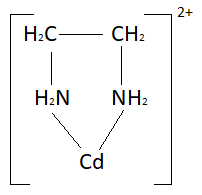
What is meant by the chelate effect? Give an example.
Answer
501.3k+ views
2 likes
Hint: Chelate is a term related to coordination compounds. When a di- or polydentate ligand uses its two or more donor atoms together to bind a single metal ion then it is said to be a chelate ligand. The number
of such ligating groups is called denticity of the ligand.
Complete answer: When a ligand is bound to a metal ion through one single donor atom then it is called unidetate but when it uses two donor atoms it is said to be a bidentate ligand.

Note:
The coordination number of the metal complex is defined as the number of ligand donor atoms to which metal is directly bonded. The central atom/ion and the ligands attached to it are enclosed in a square bracket and the term collectively used is the coordination sphere.
of such ligating groups is called denticity of the ligand.
Complete answer: When a ligand is bound to a metal ion through one single donor atom then it is called unidetate but when it uses two donor atoms it is said to be a bidentate ligand.

Note:
The coordination number of the metal complex is defined as the number of ligand donor atoms to which metal is directly bonded. The central atom/ion and the ligands attached to it are enclosed in a square bracket and the term collectively used is the coordination sphere.
Latest Vedantu courses for you
Grade 11 Science PCM | CBSE | SCHOOL | English
CBSE (2025-26)
School Full course for CBSE students
₹41,848 per year
Recently Updated Pages
Master Class 9 General Knowledge: Engaging Questions & Answers for Success

Master Class 9 English: Engaging Questions & Answers for Success

Master Class 9 Science: Engaging Questions & Answers for Success

Master Class 9 Social Science: Engaging Questions & Answers for Success

Master Class 9 Maths: Engaging Questions & Answers for Success

Class 9 Question and Answer - Your Ultimate Solutions Guide

Trending doubts
State and prove Bernoullis theorem class 11 physics CBSE

What are Quantum numbers Explain the quantum number class 11 chemistry CBSE

Write the differences between monocot plants and dicot class 11 biology CBSE

Who built the Grand Trunk Road AChandragupta Maurya class 11 social science CBSE

1 ton equals to A 100 kg B 1000 kg C 10 kg D 10000 class 11 physics CBSE

State the laws of reflection of light




